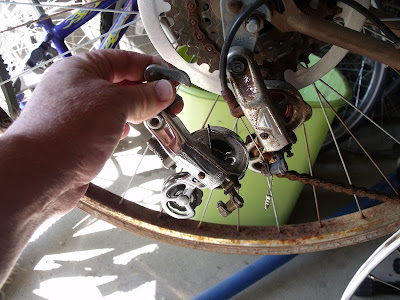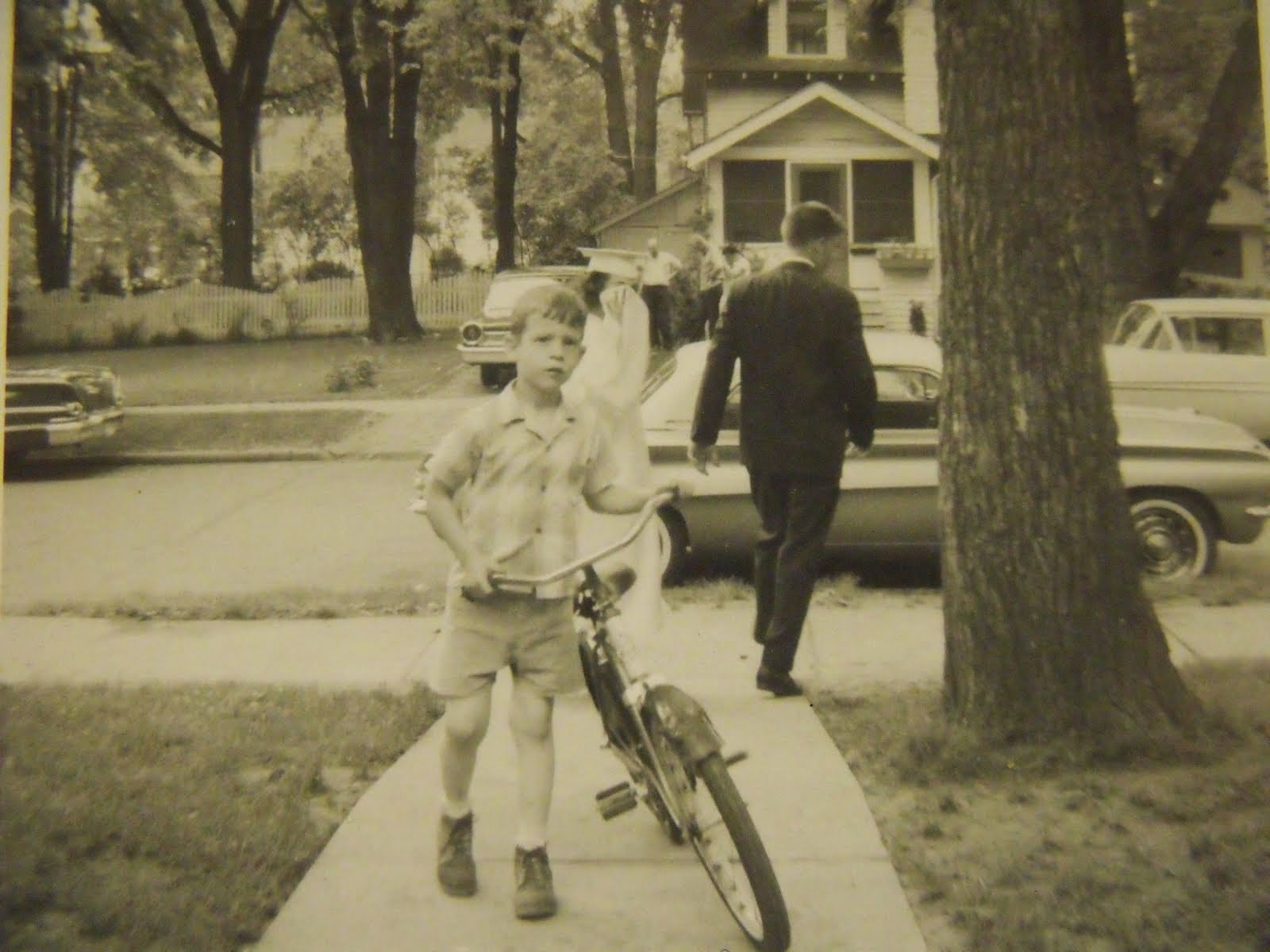Hello and Welcome,
I am restoring this 10 speed Nottingham Raleigh Sprite for Brian. Brian is the fellow who purchased my GIANT Attraction mountain bike earlier this spring. This Raleigh was apparently left outside for an extended period of time. It was badly rusted to the point where I had serious doubts about whether or not it was worth restoring. The first thing I did was take it apart and make sure the bottom bracket and headset were serviceable. As it turns out they are both savable I may need to replace the bracket spindle or axle. And it will no longer have a chain ring guard (or at least the same chain ring guard) And I may need to replace all the bearings. But all this is manageable, I guess.
Above: Here is the Sprite looking as if it doubled as a boat anchor for a couple summers. Mt first instinct was to pass simply because it needed so much replaced. But I decided to see how much I could replace using salvaged components that I already have in the shop. As it turned out I have both wheels. The rear is a perfect match to the rear wheel that is on there now (minus the rust). And I have a front wheel that I think will actually look better than the one that is on it now. Mine has a higher flanged hub that looks more retro. I also have both derailleurs, well sort of.
Above: The company that manufactured the rear derailleur for Raleigh manufactured virtually the same derailleur for Schwinn. And all things considered, I think it will do fine.
Above: My good fortune continued "or even improved" with the front derailleur. It turns out I have what appears to be the exact same Huret front derailleur in my collection of salvaged and take-off front derailleurs. This is important because, the amount of replacement parts needed "if purchased" would make this restoration way to expensive to attempt. Now for the brakes. So much of the brake caliper's hardware (springs, barrel adjusters, mounting bolts and nuts etc.etc.) has deep rust that they are not worth trying to save.
Above: At first glance, my side pull brake calipers do not look much better. But trust me on this one, these will clean-up nicely.
And although mine are Dia-Compe and the originals are Weinmann they are of equal quality. And "design wise" they are a real good match.
Above: I did not run into any surprises until I got a closer look at the lower inside blades on the original fork.
This rust is too deep and in a really bad spot. There is no way I can use this touring road fork. I knew this was going a little too well!
Above: This is really incredible! While the drop-outs are on a slightly different angle. Laying side by side the rake on the two forks is nearly identical. And this is Really Cool, The steerer tubes from the crown to the top of the tube are exactly the same length and size. I quickly tried it for fit and realized the crown races would need to be switched. So the very next day (at Cycle Therapy in Waterford Mi) I had the crown race removed and replaced with the crown race from the Raleigh fork. Then rushed home to mock it up and see if it would work.
Above: And it did work! The Bicycle Gods are shining down on me again! The original stem could not be removed! After lots of penetrating oil and tapping and twisting, I gave up and cut the S.O.B. off. I replaced it with this very "Vintage English" looking stem which I found in my tub of salvaged stems. This is why I try to never throw anything away that I think I may need at some point down the road.
Above: I really do not want to purchase new fenders. I have to repaint the frame and fork and the money is just not there. While the fenders are rusty, and the once Bronze metallic paint now appears to be a light brown. They are not dented and the struts are not all mangled. So I will try to save the touring bicycle fenders before I continue on with the frame. Lots of sanding ahead! and some wheel brushing as well.
Above: Here is the front fender after sanding and priming drying outside in the sun. Not too shabby! Looks like all I will need to replace on the fenders is the bicycle fender mounting hardware.
Above: After the Rust-Oleum Gloss Black Paint was good and dry (about 48 hours) I hung the fenders up high and out of the way so nothing bad will happen to them before I need them.
Above: A shot of the fork sanded and ready for primer. I used the fine brass wheel brush on the high speed drill to remove the paint from the area around the lug work at the top of the fork blades. You will need to wear safety glasses or goggles for that job. And a respirator (mask) if dry sanding.
Above: I like to use 220 grit (automotive) wet sanding paper followed by 400 grit and then 600 grit. This will give me a nice smooth surface for primer and paint.
Above: The fork primed and ready for paint. This is the third bike and second primer and re-paint for this fork.
This is the same fork I used on the "Stars and Stripes" fixed gear bike. Which I later cannibalized for the red lugged frame fixed gear bike.
Above: The fork drying outside in the sun. The white areas you see on the fork are glare, not missed-paint spots. And no I did not paint the fork next to my wife's car.
Above: Here is a shot of the bottom bracket shell cleaned out. I coated the threads with grease to protect them
from moisture / corrosion. The drive side would not budge. Not wanting to do any damage with my adjustable wrench I decided to leave it alone and clean it up in place. They do not give you much to lock onto on the right or drive side cup for removal.
Above: I did not have a bicycle seat post that fit the seat-tube. So I used the fine brass wheel-brush and some Turtle Wax Chrome Polish / Rust Remover to clean-up the original. For some unknown reason the size is not engraved or stamped on the original post.
Above: Here I am wet sanding the frame. I keep a rag handy as the wet sanding will smear the paint. So I need to wipe it off often to see how I am doing.
Above: Here I am rinsing paint off a piece of 220 wet sand paper so I can get the maximum use out of it. I probably used about 8 full sheets of 220 grit on this frame. I use much much less of the finer paper to smooth the finish. The great thing about wet sanding is it really keeps the dust down.
Above: To remove the paint around the head badge I use a single edge razor blade. Them finished it with a very small folded piece of sand paper. I plan to tape over the badge trimming around the perimeter with an X Acto knife before spraying primer and paint.
Above: Here is the frame "pretty much ready" for primer. I will probably do a little more touch-up before I put the primer coat on it. I will also wipe it down first "very carefully" to remove all the dust before spraying.
Above: I do not recommend you remove the cotter crank pins in this manner, especially if you are not experienced. I use penetrating oil, a lug nut and a large heavy duty C Clamp and a small propane torch. I have learned to give it a little time, it usually pops the pin loose when I least expect it. When the pin breaks loose the clamp and nut and pin all fall on the floor. So I am careful not to leave anything breakable underneath.
Above : Early on I put my wheels on to check for fit. The rear wheel was originally going to be my replacement rear wheel for the Parliament. But it has a little pitting. So I refurbished the original wheel after I found-out that Joe at American Cycle and Fitness in Pontiac had the correct (1969)free wheel removal tool. But even with a little pitting, this wheel is a hundred times nicer than I could ever make the original.
So that's about where I am at with the Raleigh Sprite. Tomorrow I prime and paint the lugged frame. Then I will get busy with the crank and headset.
Above: I added a rack bag to the single speed/fixed gear "touring style" commuter bike. Now I can bring along my camera every time I ride. I have already missed a couple of really good photo ops this spring. Eventually I will add cheap panniers to the rear bicycle rack for running errands. Can you spot what is not quite correct on this bike?
I should have much more progress to post on the blog next week. So Until Then Please RIDE SAFE and Remember to Always....RESCUE, RESTORE & RECYCLE!
Cheers, Hugh
Outdoor Ventures Packable Jacket Review
1 week ago




































































